2022 TOYOTA TUNDRA HYBRID fuel
[x] Cancel search: fuelPage 450 of 618
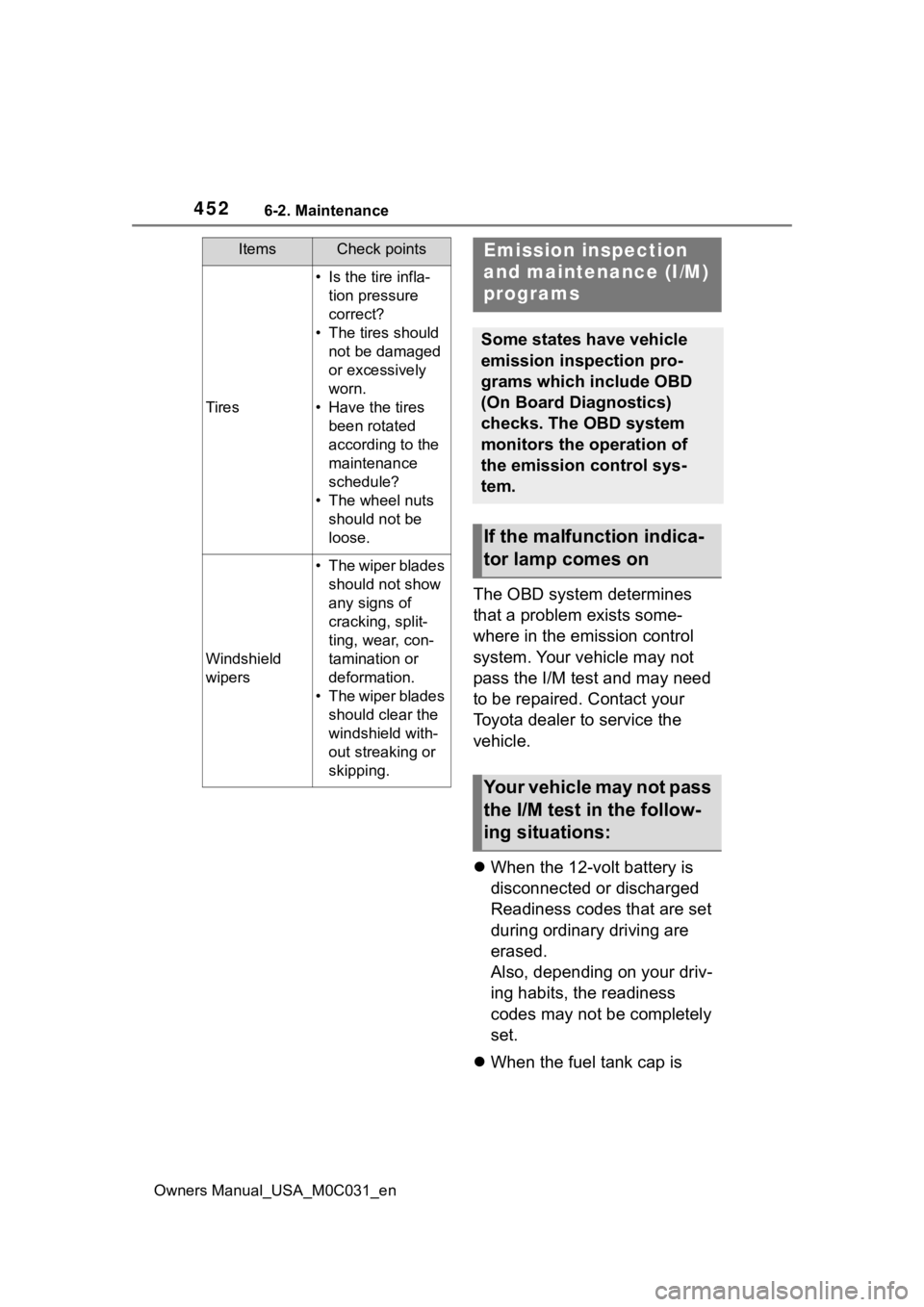
4526-2. Maintenance
Owners Manual_USA_M0C031_en
The OBD system determines
that a problem exists some-
where in the emission control
system. Your vehicle may not
pass the I/M test and may need
to be repaired. Contact your
Toyota dealer to service the
vehicle.
When the 12-volt battery is
disconnected or discharged
Readiness codes that are set
during ordinary driving are
erased.
Also, depending on your driv-
ing habits, the readiness
codes may not be completely
set.
When the fuel tank cap is
Tires
• Is the tire infla-
tion pressure
correct?
• The tires should not be damaged
or excessively
worn.
• Have the tires been rotated
according to the
maintenance
schedule?
• The wheel nuts should not be
loose.
Windshield
wipers
• The wiper blades should not show
any signs of
cracking, split-
ting, wear, con-
tamination or
deformation.
• The wiper blades should clear the
windshield with-
out streaking or
skipping.
ItemsCheck pointsEmission inspection
and maintenance (I/M)
programs
Some states have vehicle
emission inspection pro-
grams which include OBD
(On Board Diagnostics)
checks. The OBD system
monitors the operation of
the emission control sys-
tem.
If the malfunction indica-
tor lamp comes on
Your vehicle may not pass
the I/M test in the follow-
ing situations:
Page 453 of 618

4556-3. Do-it-yourself maintenance
Owners Manual_USA_M0C031_en
6
Maintenance and care
Light bulbs
( P.491)
• Bulb with same
number and
wattage rating as
original
• Phillips-head screwdriver
• Wrench
Radiator and
condenser
( P.461)
Tire inflation
pressure
( P.476)• Tire pressure
gauge
• Compressed air source
Washer fluid
( P.462)
• Water or washer
fluid containing
antifreeze (for
winter use)
• Funnel (used only for adding
water or washer
fluid)
WARNING
The engine compartment contains
many mechanisms and fluids that
may move suddenly, become hot,
or become electrically energized.
To avoid death or serious injury,
observe the following precautions.
■When working on the engine
compartment
●Make sure that the “ACCES-
SORY” or “IGNITION ON” on
the multi-inform ation display
and the “READY” indicator are
both off.
●Keep hands, clothing and tools
away from the moving fan and
engine.
ItemsParts and tools●Be careful not to touch the
engine, inverter, radiator,
exhaust manifold, etc., right
after driving as they may be hot.
Oil and other fluids may also be
hot.
●Do not leave anything that may
burn easily, such as paper and
rags, in the engine compart-
ment.
●Do not smoke, cause sparks or
expose an open flame to fuel.
■When working near the elec-
tric cooling fan or radiator
grille
Be sure the power switch is off.
With the power switch in ON, the
electric cooling fa n may automati-
cally start to run if the air condi-
tioning is on and/or the coolant
temperature is high. ( P.461)
■Safety glasses
Wear safety glasses to prevent
flying or falling material, fluid
spray, etc., from getting in your
eyes.
NOTICE
■If you remove the air cleaner
filter
Driving with the air cleaner filter
removed may cause excessive
engine wear due to dirt in the air.
Page 474 of 618
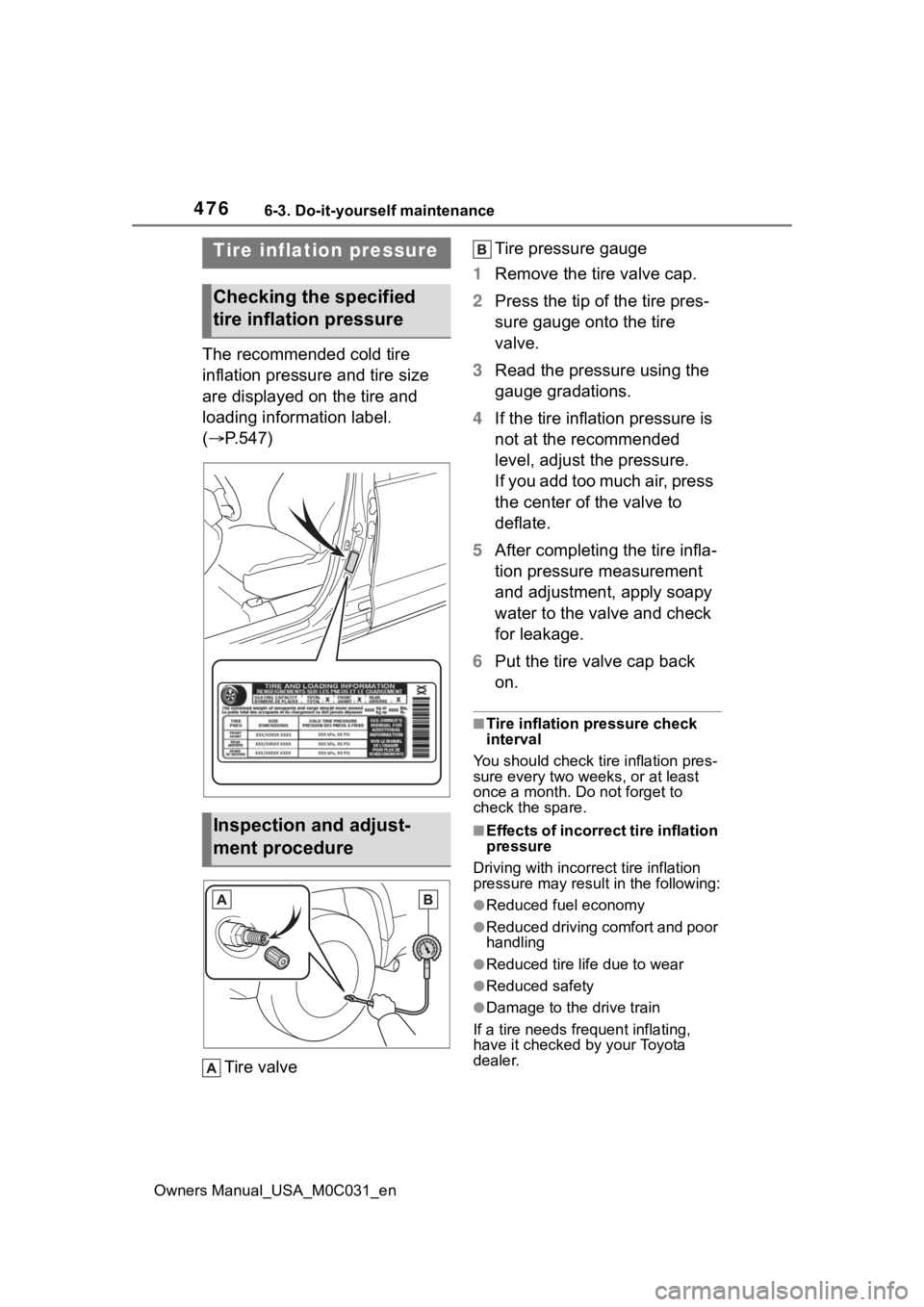
4766-3. Do-it-yourself maintenance
Owners Manual_USA_M0C031_en
The recommended cold tire
inflation pressure and tire size
are displayed on the tire and
loading information label.
(P.547)
Tire valve Tire pressure gauge
1 Remove the tire valve cap.
2 Press the tip of the tire pres-
sure gauge onto the tire
valve.
3 Read the pressure using the
gauge gradations.
4 If the tire inflation pressure is
not at the recommended
level, adjust the pressure.
If you add too much air, press
the center of the valve to
deflate.
5 After completing the tire infla-
tion pressure measurement
and adjustment, apply soapy
water to the valve and check
for leakage.
6 Put the tire valve cap back
on.
■Tire inflation pressure check
interval
You should check ti re inflation pres-
sure every two week s, or at least
once a month. Do not forget to
check the spare.
■Effects of incorrect tire inflation
pressure
Driving with incorrec t tire inflation
pressure may resul t in the following:
●Reduced fuel economy
●Reduced driving comfort and poor
handling
●Reduced tire life due to wear
●Reduced safety
●Damage to the drive train
If a tire needs frequent inflating,
have it checked by your Toyota
dealer.
Tire inflation pressure
Checking the specified
tire inflation pressure
Inspection and adjust-
ment procedure
Page 479 of 618
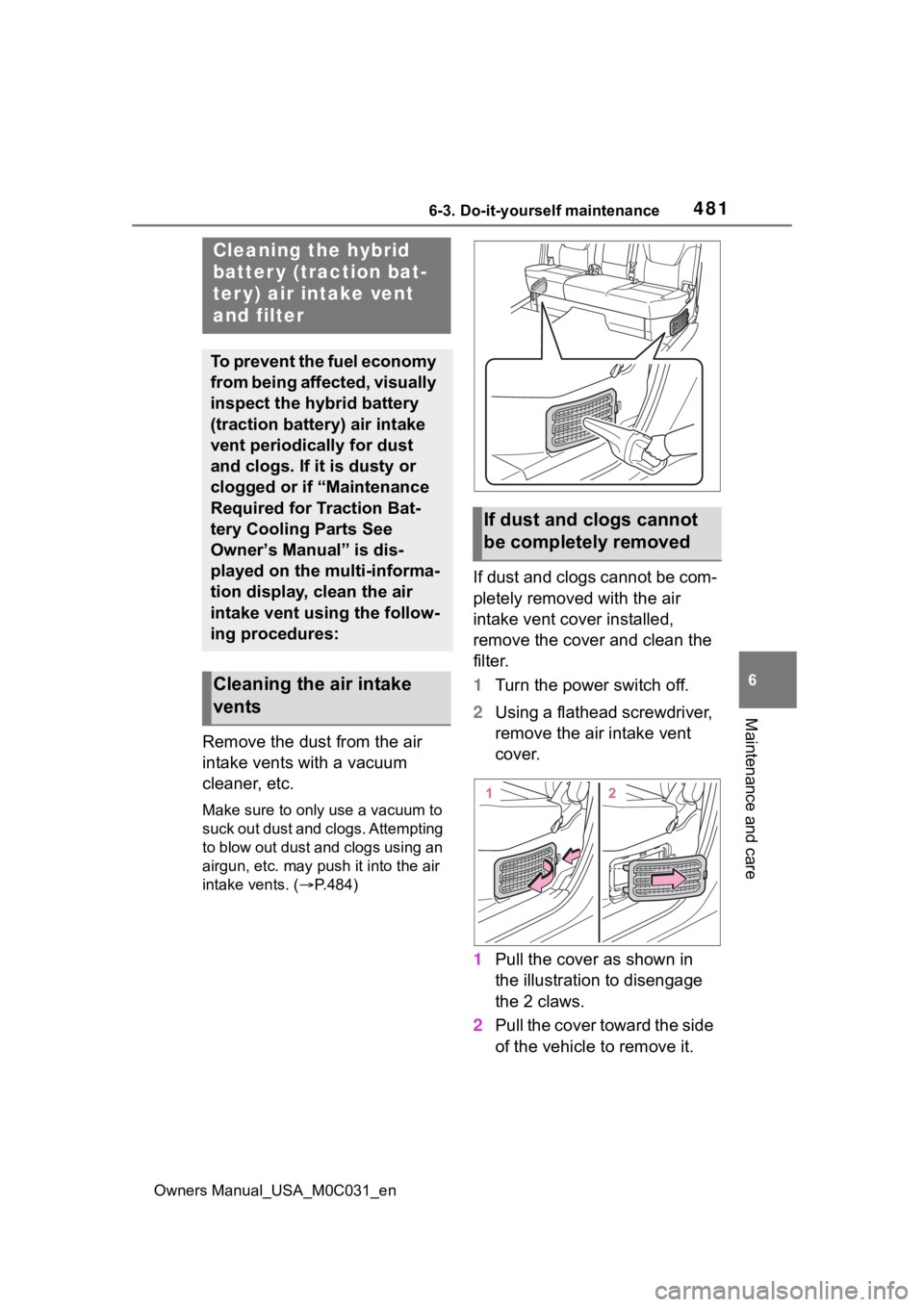
4816-3. Do-it-yourself maintenance
Owners Manual_USA_M0C031_en
6
Maintenance and care
Remove the dust from the air
intake vents with a vacuum
cleaner, etc.
Make sure to only use a vacuum to
suck out dust and clogs. Attempting
to blow out dust and clogs using an
airgun, etc. may push it into the air
intake vents. ( P.484)
If dust and clogs cannot be com-
pletely removed with the air
intake vent cover installed,
remove the cover and clean the
filter.
1Turn the power switch off.
2 Using a flathead screwdriver,
remove the air intake vent
cover.
1 Pull the cover as shown in
the illustration to disengage
the 2 claws.
2 Pull the cover toward the side
of the vehicle to remove it.
Cleaning the hybrid
batter y (traction bat-
ter y) air intake vent
and filter
To prevent the fuel economy
from being affected, visually
inspect the hybrid battery
(traction battery) air intake
vent periodically for dust
and clogs. If it is dusty or
clogged or if “Maintenance
Required for Traction Bat-
tery Cooling Parts See
Owner’s Manual” is dis-
played on the multi-informa-
tion display, clean the air
intake vent using the follow-
ing procedures:
Cleaning the air intake
vents
If dust and clogs cannot
be completely removed
Page 481 of 618
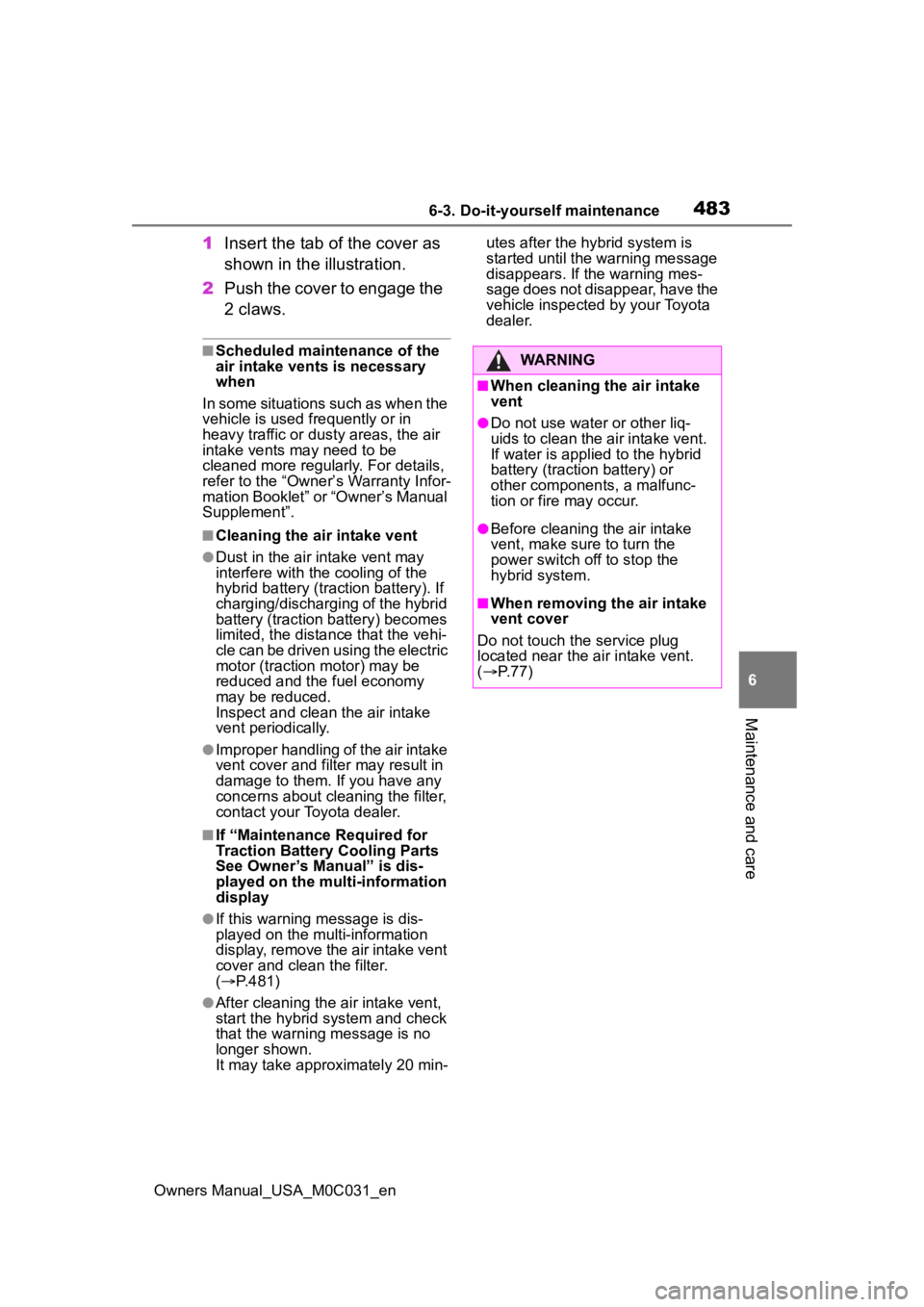
4836-3. Do-it-yourself maintenance
Owners Manual_USA_M0C031_en
6
Maintenance and care
1 Insert the tab of the cover as
shown in the illustration.
2 Push the cover to engage the
2 claws.
■Scheduled maintenance of the
air intake vents is necessary
when
In some situations such as when the
vehicle is used frequently or in
heavy traffic or dusty areas, the air
intake vents may need to be
cleaned more regularly. For details,
refer to the “Owner’ s Warranty Infor-
mation Booklet” or “Owner’s Manual
Supplement”.
■Cleaning the air intake vent
●Dust in the air intake vent may
interfere with the cooling of the
hybrid battery (traction battery). If
charging/discharging of the hybrid
battery (traction battery) becomes
limited, the distance that the vehi-
cle can be driven using the electric
motor (traction motor) may be
reduced and the fuel economy
may be reduced.
Inspect and clean the air intake
vent periodically.
●Improper handling of the air intake
vent cover and filt er may result in
damage to them. If you have any
concerns about cleaning the filter,
contact your Toyota dealer.
■If “Maintenance Required for
Traction Battery Cooling Parts
See Owner’s Manual” is dis-
played on the multi-information
display
●If this warning message is dis-
played on the multi-information
display, remove the air intake vent
cover and clean the filter.
( P.481)
●After cleaning the air intake vent,
start the hybrid system and check
that the warning message is no
longer shown.
It may take approximately 20 min- utes after the hybrid system is
started until the warning message
disappears. If the warning mes-
sage does not disappear, have the
vehicle inspected by your Toyota
dealer.
WARNING
■When cleaning the air intake
vent
●Do not use water or other liq-
uids to clean the air intake vent.
If water is applied to the hybrid
battery (traction battery) or
other components, a malfunc-
tion or fire may occur.
●Before cleaning
the air intake
vent, make sure to turn the
power switch off to stop the
hybrid system.
■When removing the air intake
vent cover
Do not touch the service plug
located near the air intake vent.
( P. 7 7 )
Page 491 of 618
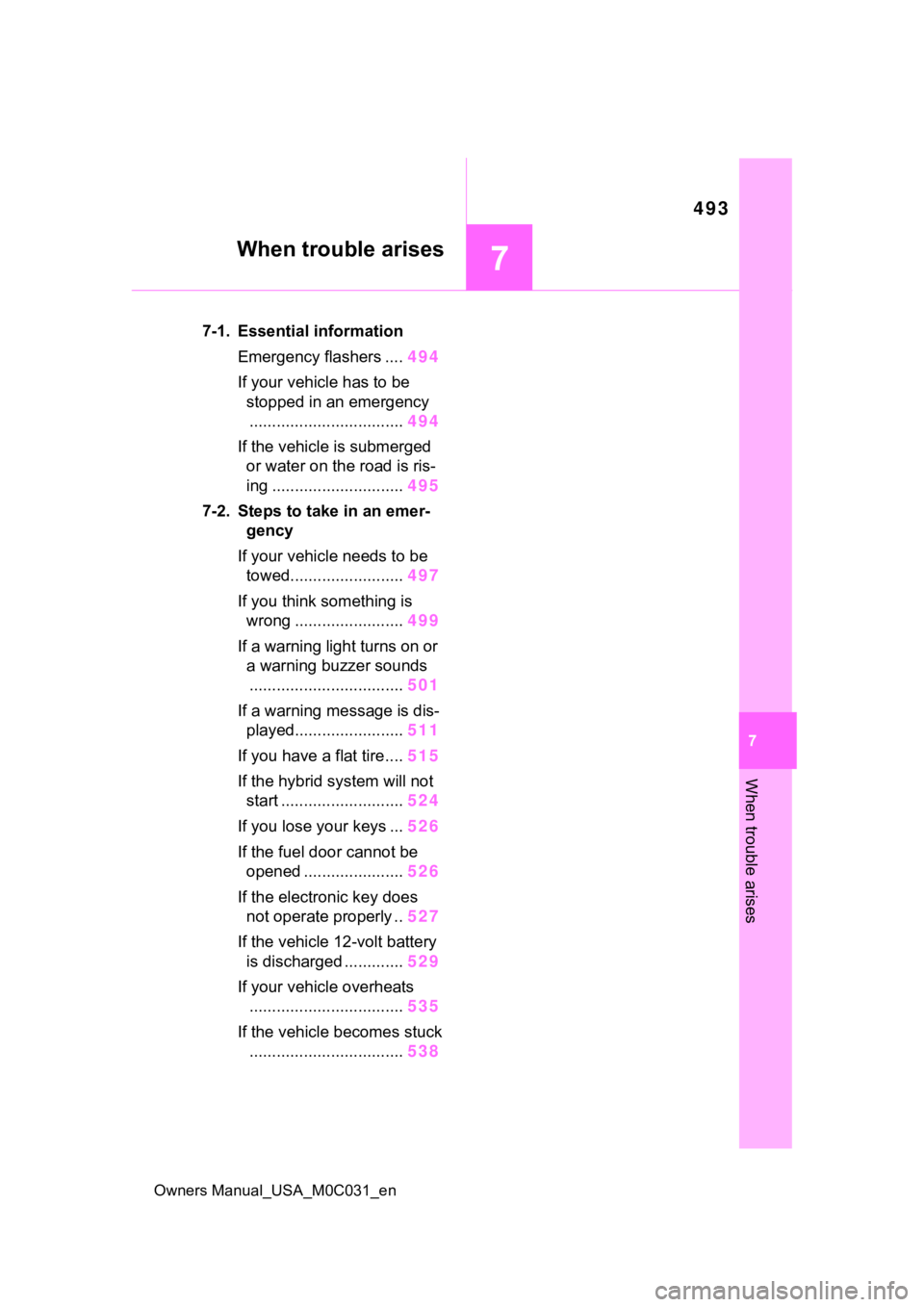
493
Owners Manual_USA_M0C031_en
7
7
When trouble arises
When trouble arises
7-1. Essential informationEmergency flashers .... 494
If your vehicle has to be stopped in an emergency.................................. 494
If the vehicle is submerged or water on the road is ris-
ing ............................. 495
7-2. Steps to take in an emer- gency
If your vehicle needs to be towed......................... 497
If you think something is wrong ........................ 499
If a warning light turns on or a warning buzzer sounds
.................................. 501
If a warning message is dis- played........................ 511
If you have a flat tire.... 515
If the hybrid system will not start ........................... 524
If you lose your keys ... 526
If the fuel door cannot be opened ...................... 526
If the electronic key does not operate properly .. 527
If the vehicle 12-volt battery is discharged ............. 529
If your vehicle overheats .................................. 535
If the vehicle becomes stuck .................................. 538
Page 505 of 618
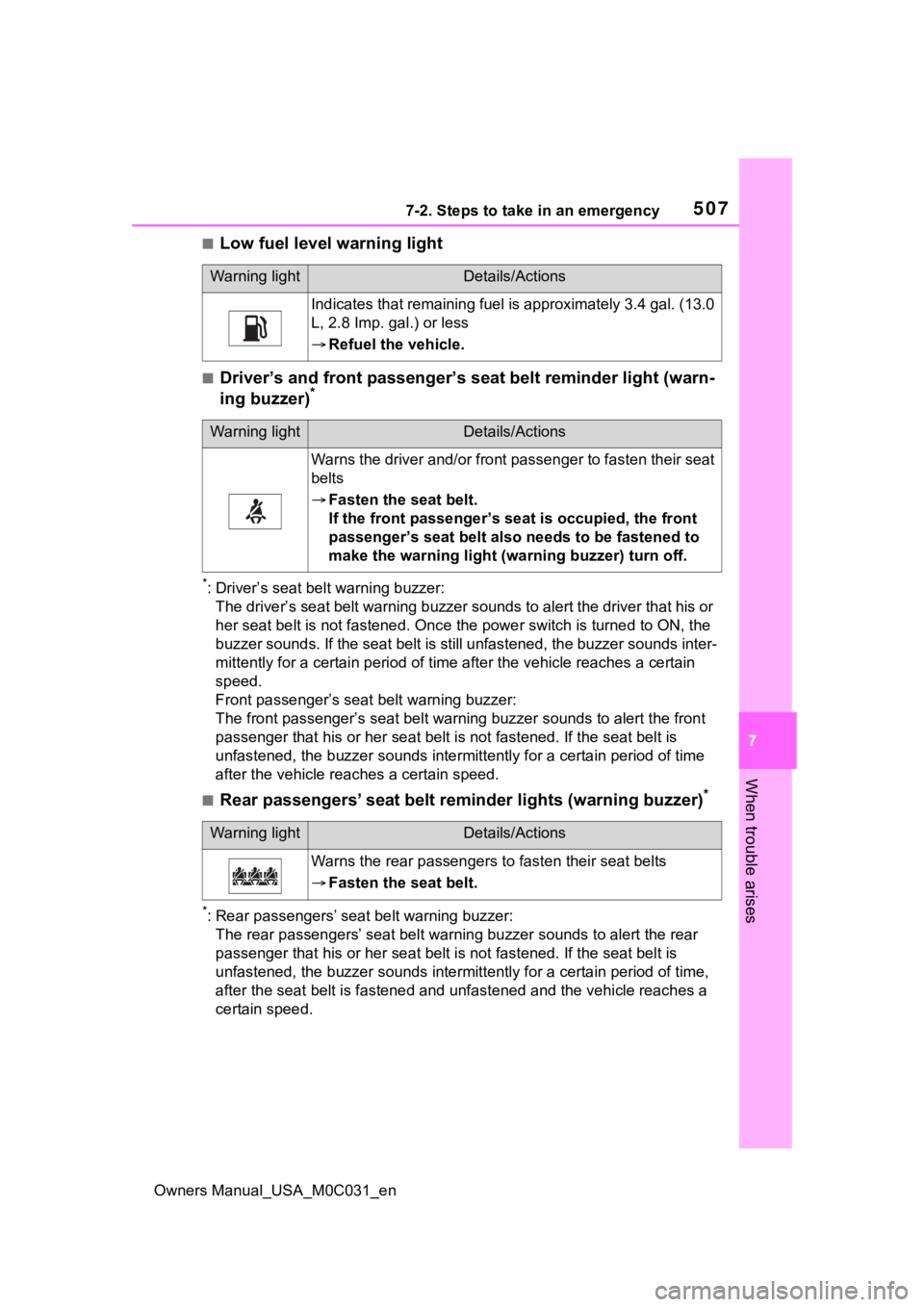
5077-2. Steps to take in an emergency
Owners Manual_USA_M0C031_en
7
When trouble arises
■Low fuel level warning light
■Driver’s and front passenger’s seat belt reminder light (warn-
ing buzzer)*
*: Driver’s seat bel t warning buzzer:
The driver’s seat belt warning buzzer sounds to alert the drive r that his or
her seat belt is not fastened. Onc e the power switch is turned to ON, the
buzzer sounds. If the seat belt is still unfastened, the buzzer sounds inter-
mittently for a certain period o f time after the vehicle reaches a certain
speed.
Front passenger’s seat belt warning buzzer:
The front passenger’s seat belt warning buzzer sounds to alert the front
passenger that his or her seat belt is not fastened. If the sea t belt is
unfastened, the buzzer sounds int ermittently for a certain period of time
after the vehicle reaches a certain speed.
■Rear passengers’ seat belt reminder lights (warning buzzer)*
*: Rear passengers’ seat belt warning buzzer:
The rear passengers’ seat belt war ning buzzer sounds to alert the rear
passenger that his or her seat belt is not fastened. If the sea t belt is
unfastened, the buzzer sounds int ermittently for a certain period of time,
after the seat belt is fastened and unfastened and the vehicle reaches a
certain speed.
Warning lightDetails/Actions
Indicates that remaining fuel is approximately 3.4 gal. (13.0
L, 2.8 Imp. gal.) or less
Refuel the vehicle.
Warning lightDetails/Actions
Warns the driver and/or front passenger to fasten their seat
belts
Fasten the seat belt.
If the front passenger’s seat is occupied, the front
passenger’s seat belt also needs to be fastened to
make the warning light (warning buzzer) turn off.
Warning lightDetails/Actions
Warns the rear passengers to fasten their seat belts
Fasten the seat belt.
Page 506 of 618

5087-2. Steps to take in an emergency
Owners Manual_USA_M0C031_en
■Air suspension malfunction indicator
■Trailer brake warning light
■Warning buzzer
In some cases, the buzzer may not
be heard due to being in a noisy
location or audio sound.
■Front passenger detection sen-
sor, seat belt reminder and
warning buzzer
●If luggage is placed on the front
passenger seat, the front passen-
ger detection sensor may cause
the warning light to flash and the
warning buzzer to sound even if a
passenger is not sitting in the
seat.
●If a cushion is placed on the seat,
the sensor may n ot detect a pas-
senger, and the warning light may
not operate properly.
■SRS warning light
This warning light system monitors
the airbag sensor assembly, front
impact sensors, side impact sensors
(front door), side impact sensors
(front), side impact sensors (rear),
driver’s seat position sensor,
driver’s seat belt buckle switch, front
passenger occupant classification
sensors, “AIR BAG ON” indicator
light, “AIR BAG OFF” indicator light,
front passenger’s seat belt buckle
switch, seat belt pretensioners, air- bags, interconnecting wiring and
power sources. (
P. 3 7 )
■If the malfunction indicator
lamp comes on while driving
First check the following:
●Is the fuel tank empty?
If it is, fill the fuel tank immediately.
●Is the fuel ta nk cap loose?
If it is, tighten it securely.
The light will go off after several
driving trips.
If the light does not go off even after
several trips, con tact your Toyota
dealer as soon as possible.
■Electric power steering system
warning light (warning buzzer)
When the 12-volt battery charge
becomes insufficient or the voltage
temporarily drops, the electric power
steering system warning light may
come on and the warning buzzer
may sound.
■When the tire pressure warning
light comes on
Inspect the tires to check if a tire is
punctured.
If a tire is punctured: P. 5 1 5
If none of the tires are punctured:
Warning lightDetails/Actions
(If equipped)
Indicates a malfunction in the air suspension system
Have the vehicle inspecte d by your Toyota dealer
immediately.
Warning lightDetails/Actions
Indicates a malfunction in:
Trailer brake control system; or
Trailer connector circuit
Have the vehicle inspecte d by your Toyota dealer
immediately.